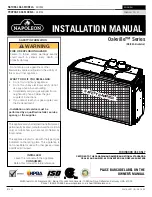
131
2. PTS (Power Transfer Switch)
The Power Transfer Switch is used to control the flow of power between the utility line,
the MP2000E, and the output load. During normal operation, the utility line is fed into
the PTS and the PTS distributes the utility line to the load as well as the BBS to allow
battery charging to occur. If the utility line fails, buck mode or boost mode operation
is enabled the PTS will only supply the utility line to the MP2000E and direct the output
of the MP2000E to support the load.
a. Verify the utility line is reaching the PTS by measuring the voltage on the L IN
terminal with respect to ground. If voltage is not present see step 1
– MBPS.
b. Verify buck and boost operation is disabled and the MP2000E is operating in line
mode. If any of these conditions exist see troubleshooting MP2000E.
c. Measure the voltage at the AC input to the MP2000E with respect to neutral. If voltage
is not present check the BBS input AC breaker on the PTS. If it is reset then the PTS
is defective. If the breaker cannot be reset, open the AC input breaker on the
MP2000E and try to reset the breaker. If it still cannot be reset then the PTS is
defective. If the breaker can be reset the see troubleshooting MP2000E.
d. Unplug all devices from the 5-15R duplex outlet. Measure the voltage at the 515R
duplex outlet. If voltage is not present ensure the circuit breaker labeled outlet
receptacle is reset. If the circuit breaker cannot be reset or the circuit breaker is
reset but there still is no voltage at outlet, the PTS is defective.
e. Measure the voltage at the L OUT terminals of the PTS with respect to neutral. If no
voltage is present ensure step b has been verified, check the wiring from the PTS to
ensure it is connected to the PTS terminal location on the MP2000E, and then
measure the DC voltage on the MP2000E Terminal Block pin 22 (positive) with
respect to pin 21 (negative) to ensure the voltage is zero. If the voltage is not zero
then the MP2000E is defective. If the voltage is zero then the PTS is defective.
f. Measure the line voltage on the AC output terminal block of the MP2000E with
respect to neutral. If the voltage is zero see troubleshooting MP2000E.
g. If the voltage is present enable the MP2000E in buck mode or boost mode. You
should immediately hear the contactor in the PTS engage.
h. If you do not hear the contactor engage, measure the DC voltage on the MP2000E
Terminal Block pin 22 (positive) with respect to pin 21 (negative) to ensure the
voltage is between 40-60VDC. If the voltage is not then the MP2000E is defective. If
the voltage is between 40-60VDC and the contactor has not picked up then the PTS
is defective.
i. Measure the voltage at the L OUT terminal block with respect to neutral. If the voltage
is not present the PTS is defective.
3. MP2000E (Battery Back-up System)
The MP2000E is a Battery Backup System that under normal operation passes the AC
input to the AC output. If the utility line falls out of tolerance the unit will disconnect
from the AC utility source and invert the batteries DC voltage to an AC voltage to
support the load.
a. Line Mode Operation
•
Ensure the status of the MP2000E is in line mode and no faults are present.
Содержание MP Series
Страница 3: ...III ...
Страница 20: ...20 STEP 1 Connect CONTROL Wires ...
Страница 22: ...22 Installation and Troubleshooting Guide Figure 9 ...
Страница 30: ...30 MP2000E System Battery Backup System Section 2 Operator s Manual ...
Страница 49: ...49 Figure 21 Note See Section 2 2 14 For details on Event Log View under Maintenance submenu ...
Страница 51: ...51 2 2 8 Status Submenu CONT D ...
Страница 70: ...70 2 3 3 Main Menu ...
Страница 72: ...2 3 4 1 RS232 USB Menu Tree ...
Страница 74: ...74 ...
Страница 104: ...104 Figure 6 70 SMS for Event Log Screen ...
Страница 126: ...126 ...
Страница 148: ...148 ...
















































